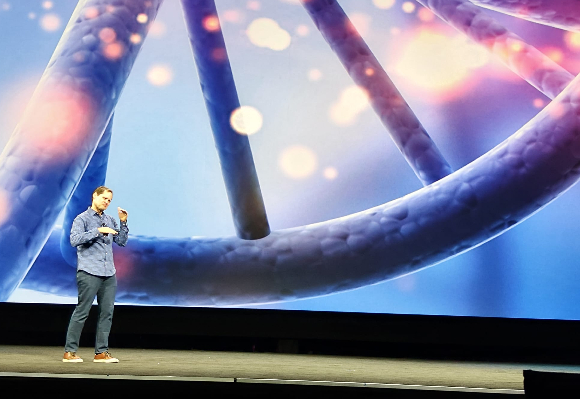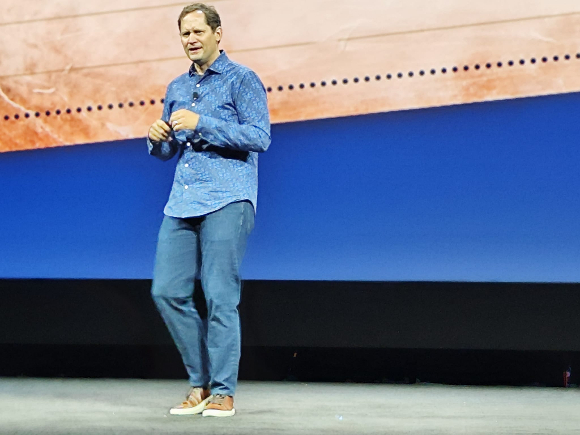PegaWorld iNspire 2023: Day #2 live report
As low-code gets lower (by which we mean higher), we need to track the progress of this potentially game-changing (stay with us, we’ll justify that phrase) technology as it continues to expand and proliferate.
If low-code is game-changing, it might be because it could enable a more composable layered approach to software application development where we finally (because we are able to remove components) get to a point where we eradicate legacy software i.e. we can simply “change” software when we need to.
This may be why Pega styles itself around the tagline Build For Change – spoiler alert, that’s EXACTLY why Pega does that.
This year’s PegaWorld iNspire 2023 held in Las Vegas saw the Computer Weekly Developer Network team attend the show itself with a view to extracting the most pertinent news items, themes and trends.
Dr Rob Walker, Pega GM for 1:1 customer engagement hosted the day two keynote. He tabled a survey which suggests that (as of today at least) some 3 in 5 people believe they can distinguish between human generated content and AI content. Suggesting that this line will become invisible very soon, Walker obviously offered this info due to the Pega GenAI technology that the company has now engineered into its platform.
In a world where an AI engine can explain the following joke, Walker suggests that we need to think about the way algorithms are being built and how much intent they harbour – and how much AI risk there really is out there – so the joke we need to ponder reads as follows below:
What’s the difference between Dubai and Abu-Dhabi?
People in Dubai don’t like The Flinstones, but people in Abu-Dhabi do.
The question is, does an AI engine really “understand” this joke and appreciate why it is funny, or does it just “know” about it?
Dr Walker reminds us that humans can generally only ‘balance’ around 7-different factors, thoughts, theories and concepts in their mind at any one time (it’s often said that children can learn up to seven languages at one time when growing up and they do well UNTIL an eight language is introduced), but of course we know that AI engines can juggle and balance hundreds or even thousands of elements all at the same time.
As we now look at the difference between ‘explainable AI’ and so-called ‘opaque AI’ exists (the opaque kind not having the ability to explain and validate its workings and actions), we have some conundrums to think about. We know that opaque AI performs better – largely because it doesn’t have to expend compute and data science energy on explaining its workings – but it doesn’t explain how it works. If a human doctor gets diagnoses right 85% of the time and opaque AI gets diagnoses right 95% of the time, but still doesn’t explain how – humans (as we stand today) are more likely to trust a human doctor.
“We need to get to some kind of point between these two realities,” said Walker.
Pega Cloud on Google Cloud
Pega used the PegaWorld iNspire 2023 event itself to detail news of the availability of its Pega Cloud solutions on Google Cloud Services (GCS) as a fully managed as-a-service offering.
The concept here is simple enough to explain, the company wants to get to a place where Pega Cloud clients can use GCS as a secure and scalable founfation to run Pega’s low-code platform for AI-powered decisioning and workflow automation solutions – but now, they can do so in a place where they can bring their Pega Cloud solutions closer to key Google services to activate their data.
Google data services proximity
For example, joint customers can now aggregate customer behaviour events with Google’s Big Query data warehouse and ingest them into Pega Customer Decision Hub to provide pre-summarised insights to run Pega’s adaptive AI-powered decisioning models.
In the future, joint clients will also be able to incorporate Google’s generative AI services with Pega Infinity to accelerate low-code development, optimise personalised engagement and assist users and customers.
“The availability of Pega Cloud on Google Cloud will offer tremendous value to our clients by providing the security, reliability and scalability our clients demand for deploying and managing their Pega applications,” said Frank Guerrera, chief technical systems officer, Pega. “This marks a significant milestone in our deep partnership with Google Cloud and we look forward to offering more innovations together in the future.”
In addition, Pega Cloud is now available in Google Marketplace, which allows clients to easily procure Pega Cloud solutions and apply their investment towards their Google Cloud commitment.
“Through this partnership, organisations can easily deploy and scale Pega Cloud on Google Cloud’s trusted, global infrastructure,” said Pallab Deb, managing director, partnerships, Google Cloud. “We’re excited to continue our work with Pega to help businesses quickly see value from their Pega applications and to help them automate and streamline many of their most common business processes and tasks.”
This news of course means that Pega Cloud offers a multi-cloud SaaS approach so that customers can deploy Pega in the way that best suits their business needs – and this could be due to a need to expand market reach, satisfy compliance demands in certain regions and strategically align their new and existing technology.
Resiliency, utilisation & optimisation
Pega also recently introduced enhancements to Pega Cloud supported by an enhanced Global Operations Centre to deliver a more scalable, reliable and secure foundation for its suite of AI-powered decisioning and workflow automation solutions.
These enhancements are hoped to improve resiliency, utilisation and resource optimisation so businesses can maximise their technology investments to deliver better experiences for employees and customers.
CTO: Chief Translation Officer
Pega CTO Don Schuerman rounded out the company’s day two keynote session. He notes that – as a chief technology officer and – he likes to call himself a chief translation officer.
“In this context, that means being able to translate technology into value for our customers and being able to translate customer needs into our roadmap so that we reflect those desires in our Pega platform functionalities,” said Schuerman, while on stage in Las Vegas.
Schuerman spoke at length on the parallels between [food cooking] recipes and the ‘recipes’ that we now use as the instruction sets that we use to build our AI algorithms. With parallels also seen in DNA structures, Schuerman talked also about the need for aeroplanes to have both human pilots and autopilot systems.
“Image an auto-pilot for developers that might be able to help build an insurance claims service into an application – the developer would be able to review, change and approve the code integration before it was deployed. But now imagine a process autopilot that works to optimise an entire business,” said Schuerman. “We have been talking about autonomous enterprises running with self-optimising processes for some time now – and even though this is not [full] the technology that you’ll find in Pega Infinity ‘23 today, but it is where we are going and I need you [the audience, the users’ the developers] to use our technologies and others to help us all evolve.”
Schuerman concluded by saying that in the immediate future, we will see developer productivity doubled and many partners will have built technologies on Page Launchpad. It’s all about continuously optimising the autonomous enterprise he suggested… and the show closed up with this call to action for next year.

Pega CTO Don Schuerman

CTO – Cooking Tasty Omelettes

Dr Rob Walker, Pega GM for 1:1 customer engagement on stage at the PegaWorld iNspire 2023 event in Las Vegas explaining the AI that created LOAB, the ‘opposite’ of Marlon Brando’s image.



